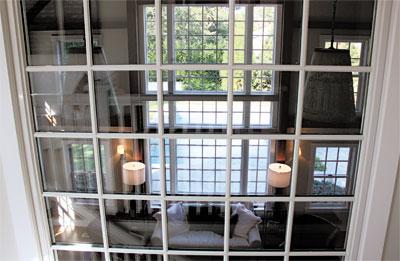High-End, Homey, and Energy-Efficient

An open house at 53 Toilsome Lane last month allowed the community an intimate look at the work of Yankee Barn Homes, a New Hampshire designer of traditional barn houses, farmhouses, carriage houses, and cottages.
The company produces its standard designs in-house — among them the East Hampton, the Tate Barn Home, the English Cottage, and the Laurel Hollow — as well as customized versions, said Jeffrey Rosen, its creative director, who has overseen the houses that have been built here to date. It can even start from scratch to create unique designs, he said, but the traditional post-and-beam approach exemplified in its standard designs is the most popular.
In East Hampton, Yankee Barn Homes are also found at 51 Toilsome Lane (English Cottage), 61 Buell Lane (based on Yankee Barn Homes’ Cottage design), and 48 Sherrill Road (a Tate Barn Home). The shell package includes wall and roof panels, a Douglas fir timber frame, exterior siding and trim, a staircase in the buyer’s choice of wood, first and second-floor sub-floors, and Andersen windows and exterior glass doors, the latter within a Douglas fir entry door. The Douglas fir timbers are sourced from members of the Sustainable Forestry Initiative; clients can also opt to use reclaimed timbers.
The roof and wall panels are built with a proprietary insulation that not only provides high thermal resistance, said Mr. Rosen, but is also more environmentally friendly than polystyrene, a common alternative. The airtight house, he said, makes for long-term savings on energy consumption.
For clients, the process begins with a phone call. “We discuss location, square footage, cost, and then have an ‘A’ phase and a ‘B’ phase,” said Mr. Rosen. The first involves a deposit, which gets the buyer a design. This can involve a visit to the company’s headquarters in the town of Grantham, a visit from a representative to the buyer, or even a meeting by videoconference. “Once we have a design, we can do a video walk-through,” Mr. Rosen said. “The house gets designed, and all final decisions are made.”
Next comes a 50-percent deposit, which puts the house in production. “It’s scheduled so that the foundation in the ground has all the local permits, which we don’t do. The platform has to be on top of a foundation,” Mr. Rosen explained.
The company delivers the shell components via tractor-trailer and either helps clients find a builder or sends an assembly crew to the site, after which the owners can hire people to complete construction. Acting as one’s own general contractor is not recommended.
Once the components have arrived, the house can be built in as little as 10 to 14 days. By virtue of its post-and-beam design, Mr. Rosen said, “it goes up as a traditional barn-raising, in the sense that you see the frame first and then all panels get put into the frame,” including roof and window installation. Interior finishing follows.
The company emphasizes green design and construction. Because the components are pre-cut, pre-fit, and essentially assembled in Grantham, significantly fewer materials are wasted, and much less garbage accumulates on the site.
Environmental sensitivity, said Mr. Rosen, has always been part of Yankee Barn Homes’ philosophy. It recycles wood shavings by donating them to local farmers, who use them as bedding for livestock, and burns scrap timber and lumber for heat. All the materials are American-made.
Its finished products evoke, as its name and the names of its houses suggest, an earlier, simpler time. This, Mr. Rosen suggested, is particularly desirable in a metropolitan region. “In the New York area,” he said, “everyone’s life is so hectic and fast. There’s a draw to a handmade appearance of a structure. That’s the whole barn movement — to embrace the past, if you will.”
